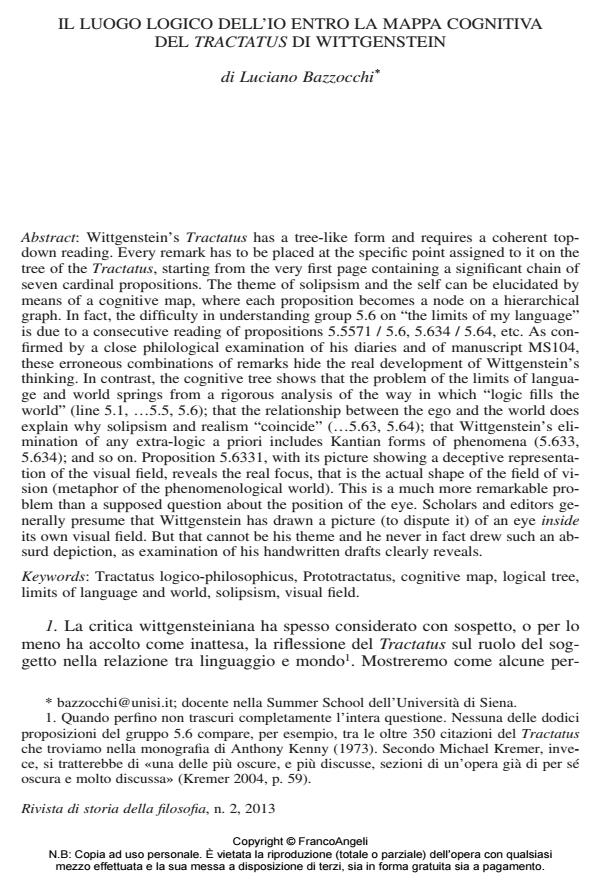Il luogo logico dell’io entro la mappa cognitiva del Tractatus di Wittgenstein
Titolo Rivista RIVISTA DI STORIA DELLA FILOSOFIA
Autori/Curatori Luciano Bazzocchi
Anno di pubblicazione 2013 Fascicolo 2013/2
Lingua Italiano Numero pagine 32 P. 273-304 Dimensione file 601 KB
DOI 10.3280/SF2013-002004
Il DOI è il codice a barre della proprietà intellettuale: per saperne di più
clicca qui
Qui sotto puoi vedere in anteprima la prima pagina di questo articolo.
Se questo articolo ti interessa, lo puoi acquistare (e scaricare in formato pdf) seguendo le facili indicazioni per acquistare il download credit. Acquista Download Credits per scaricare questo Articolo in formato PDF

FrancoAngeli è membro della Publishers International Linking Association, Inc (PILA)associazione indipendente e non profit per facilitare (attraverso i servizi tecnologici implementati da CrossRef.org) l’accesso degli studiosi ai contenuti digitali nelle pubblicazioni professionali e scientifiche
Wittgenstein’s Tractatus has a tree-like form and requires a coherent topdown reading. Every remark has to be placed at the specific point assigned to it on the tree of the Tractatus, starting from the very first page containing a significant chain of seven cardinal propositions. The theme of solipsism and the self can be elucidated by means of a cognitive map, where each proposition becomes a node on a hierarchical graph. In fact, the difficulty in understanding group 5.6 on "the limits of my language" is due to a consecutive reading of propositions 5.5571 / 5.6, 5.634 / 5.64, etc. As confirmed by a close philological examination of his diaries and of manuscript MS104, these erroneous combinations of remarks hide the real development of Wittgenstein’s thinking. In contrast, the cognitive tree shows that the problem of the limits of language and world springs from a rigorous analysis of the way in which "logic fills the world" (line 5.1, 5.5, 5.6); that the relationship between the ego and the world does explain why solipsism and realism "coincide" (5.63, 5.64); that Wittgenstein’s elimination of any extra-logic a priori includes Kantian forms of phenomena (5.633, 5.634); and so on. Proposition 5.6331, with its picture showing a deceptive representation of the visual field, reveals the real focus, that is the actual shape of the field of vision (metaphor of the phenomenological world). This is a much more remarkable problem than a supposed question about the position of the eye. Scholars and editors generally presume that Wittgenstein has drawn a picture (to dispute it) of an eye inside its own visual field. But that cannot be his theme and he never in fact drew such an absurd depiction, as examination of his handwritten drafts clearly reveals.
Parole chiave:Tractatus logico-philosophicus, Prototractatus, cognitive map, logical tree, limits of language and world, solipsism, visual field.
- The Tree-reading of the Tractatus logico-philosophicus and the recent Debate on it Luciano Bazzocchi, in RIVISTA DI STORIA DELLA FILOSOFIA 2/2021 pp.319
DOI: 10.3280/SF2021-002006
Luciano Bazzocchi, Il luogo logico dell’io entro la mappa cognitiva del Tractatus di Wittgenstein in "RIVISTA DI STORIA DELLA FILOSOFIA" 2/2013, pp 273-304, DOI: 10.3280/SF2013-002004